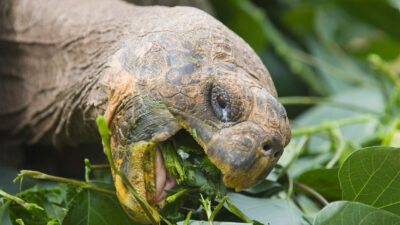Are turtles herbivores? This seemingly simple question opens the door to a fascinating exploration of the dietary habits of these ancient reptiles. Turtles, with their diverse species and habitats, have intrigued scientists and enthusiasts alike for centuries.
Yes, many turtles are herbivores. They primarily feed on plants such as algae, aquatic vegetation, and terrestrial greens. However, it’s important to note that not all turtles are strict herbivores; some species have omnivorous diets, including both plant and animal matter. The specific dietary habits of turtles can vary depending on the species and their habitat.
While many might assume that all turtles are strict herbivores due to their peaceful demeanor and seemingly plant-based environments, the reality is more nuanced. In this article, we delve into the dietary preferences of turtles, examining the variations among different species, the impact of habitat on their diets, and the intriguing adaptations that have evolved over millions of years.
How turtle anatomy influences their dietary preferences

Turtle anatomy plays a significant role in determining their dietary preferences, as their physical characteristics are adapted to specific feeding habits. Here’s how:
- Beak Structure: The shape and strength of a turtle’s beak are adapted to its primary food source. Herbivorous turtles have broad, flat beaks designed for grazing on vegetation, while carnivorous turtles have sharp, pointed beaks for capturing and tearing prey.
- Jaw Muscles: The strength and arrangement of jaw muscles differ between herbivorous and carnivorous turtles. Herbivorous turtles have stronger muscles for grinding plant matter, while carnivorous turtles have powerful muscles for biting and holding onto prey.
- Digestive System: The length and complexity of the digestive tract vary depending on the turtle’s diet. Herbivorous turtles typically have longer intestines to aid in the digestion of plant material, while carnivorous turtles have shorter intestines optimized for digesting animal protein.
- Shell Shape and Size: The shape and size of a turtle’s shell can influence its ability to forage for food. For example, turtles with streamlined shells are often better suited for swimming and hunting fish, while turtles with broader shells may be adapted for grazing on vegetation in shallow water or on land.
- Habitat: A turtle’s habitat also influences its dietary preferences. Turtles that inhabit freshwater environments may have different dietary preferences than those found in marine or terrestrial habitats. For example, freshwater turtles may feed on aquatic plants, insects, and small fish, while marine turtles may primarily consume jellyfish, seaweed, and crustaceans.
Overall, turtle anatomy is intricately linked to their dietary preferences, with adaptations that enable them to effectively consume and digest the foods available in their specific environments.
Are turtles herbivores?
Turtles exhibit a diverse range of dietary preferences, and while some species are herbivores, not all turtles fit into this category. Herbivorous turtles primarily consume plant material such as vegetation, fruits, and algae. They have evolved specialized adaptations to efficiently digest and process plant matter, including broad, flat beaks for grazing and strong jaw muscles for chewing.
However, it’s essential to recognize that the dietary preferences of turtles can vary widely depending on their species, habitat, and individual characteristics. Some turtles are omnivores, meaning they consume both plant and animal matter, while others are predominantly carnivorous, feeding on insects, fish, crustaceans, or even small mammals.
For example:
- Herbivorous turtles: Species such as the green sea turtle (Chelonia mydas) are primarily herbivorous, feeding on seagrasses and algae. Freshwater turtles like the red-eared slider (Trachemys scripta elegans) also fall into this category, grazing on aquatic vegetation.
- Omnivorous turtles: The painted turtle (Chrysemys picta) is an example of an omnivorous turtle. While it primarily feeds on aquatic plants, it also consumes insects, small fish, and carrion opportunistically.
- Carnivorous turtles: Turtles like the snapping turtle (Chelydra serpentina) are primarily carnivorous, preying on fish, amphibians, small reptiles, and even birds or mammals.
The dietary preferences of turtles are influenced by factors such as their habitat, availability of food sources, and evolutionary adaptations. Therefore, while some turtles are indeed herbivores, it’s crucial to consider the diverse range of feeding habits exhibited by different turtle species.
Classification of Turtles Based on Diet
Turtles can be classified into different dietary categories based on their feeding habits. Here are the main classifications:
- Herbivorous Turtles:
- These turtles primarily consume plant material such as vegetation, fruits, and algae.
- They have specialized adaptations for processing and digesting plant matter, including broad, flat beaks for grazing and strong jaw muscles for chewing.
- Examples include the green sea turtle (Chelonia mydas), which feeds on seagrasses and algae, and freshwater turtles like the red-eared slider (Trachemys scripta elegans), which graze on aquatic vegetation.
- Omnivorous Turtles:
- Omnivorous turtles have a varied diet that includes both plant and animal matter.
- They may feed on fruits, vegetables, insects, small fish, crustaceans, and occasionally carrion.
- Examples include the painted turtle (Chrysemys picta), which consumes aquatic plants, insects, small fish, and carrion, and the yellow-bellied slider (Trachemys scripta scripta), which has a similar omnivorous diet.
- Carnivorous Turtles:
- Carnivorous turtles primarily feed on animal protein, including fish, amphibians, small reptiles, birds, and mammals.
- They often have sharp, pointed beaks for capturing and tearing prey and strong jaw muscles for biting.
- Examples include the snapping turtle (Chelydra serpentina), known for its carnivorous diet of fish, amphibians, and even small birds or mammals, and the alligator snapping turtle (Macrochelys temminckii), which is a formidable predator in aquatic ecosystems.
- Specialized Feeders:
- Some turtles have specialized diets that are unique to their species or habitat.
- For example, leatherback sea turtles (Dermochelys coriacea) are primarily carnivorous, feeding on jellyfish, while the Aldabra giant tortoise (Aldabrachelys gigantea) is primarily herbivorous, grazing on grasses and browsing on shrubs.
These classifications provide a general framework for understanding the dietary preferences of turtles, but it’s important to note that there can be variations within species and individuals, and some turtles may exhibit opportunistic feeding behaviors depending on food availability and environmental conditions.


